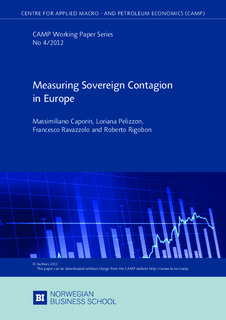Measuring sovereign contagion in Europe
Working paper
Permanent lenke
http://hdl.handle.net/11250/196667Utgivelsesdato
2014-06-24Metadata
Vis full innførselSamlinger
Sammendrag
This paper analyzes the sovereign risk contagion using credit default swaps (CDS) and bond
premiums for the major eurozone countries. By emphasizing several econometric approaches
(nonlinear regression, quantile regression and Bayesian quantile regression with heteroskedasticity) we show that propagation of shocks in Europe's CDS has been remarkably constant for
the period 2008-2011 even though a significant part of the sample periphery countries have
been extremely affected by their sovereign debt and fiscal situations. Thus, the integration
among the different eurozone countries is stable, and the risk spillover among these countries
is not affected by the size of the shock, implying that so far contagion has remained subdue.
Results for the CDS sample are confirmed by examining bond spreads. However, the analysis
of bond data shows that there is a change in the intensity of the propagation of shocks in the
2003-2006 pre-crisis period and the 2008-2011 post-Lehman one, but the coefficients actually
go down, not up! All the increases in correlation we have witnessed over the last years come
from larger shocks and the heteroskedasticity in the data, not from similar shocks propagated
with higher intensity across Europe. This is the first paper, to our knowledge, where a Bayesian
quantile regression approach is used to measure contagion. This methodology is particularly
well-suited to deal with nonlinear and unstable transmission mechanisms.
